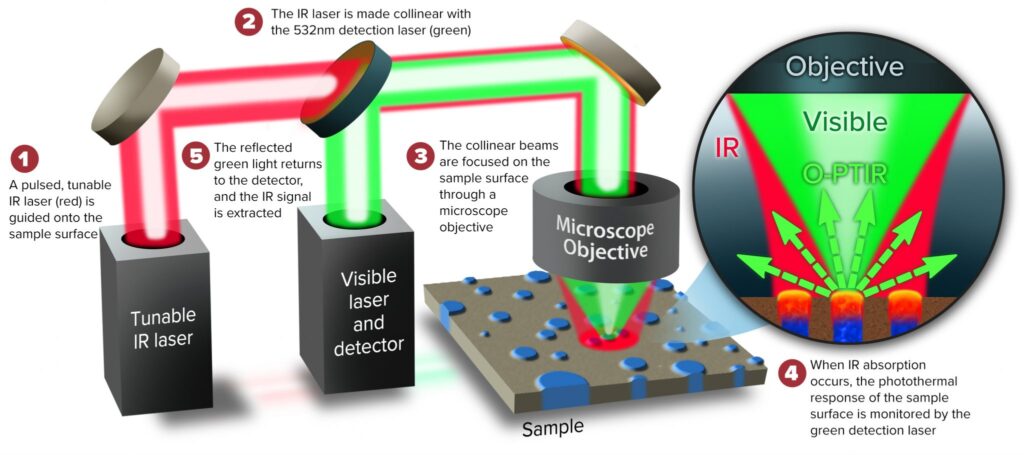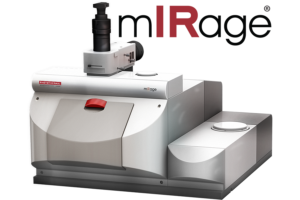Table Of Contents
How does O-PTIR work?
Optical Photothermal Infrared, or O-PTIR, is using a visible laser and detector, to overcome the main limitation of a traditional FTIR microscope. An FTIR microscope has a spatial resolution dependant on the wavelength. OPTIR’s visible laser’s wavelength (532nm) is co-aligned with the IR laser, exciting the sample, resulting in an IR response based on the IR absorption of the sample. Because the visible laser is also used for detection, the IR response can be measured at the same spatial resolution as the 532nm wavelength visible laser.
A schematic diagram of O-PTIR is shown below:

Why use O-PTIR?
Standard FTIR techniques are limited in spatial resolution due to their wavelength dependency. By using a visible laser as a detection method for the IR absorption of a sample, the spatial resolution of the O-PTIR instrument is limited to the wavelength of the visible laser that is used. In the mIRage instruments, a 532nm green visible laser is used, resulting in a maximum spatial resolution of 532 nanometer.
This technique allows for research on a much smaller scale than traditional FTIR microscopes. Now, instead of bulk measurements, a localized measurement can be performed, resulting in more precise, and even more detailed information.
When measuring a homogeneous sample in reflection mode, the spectra from transmission FTIR and O-PTIR will correllate perfectly. Differences in resulting spectra, may be from unexpected inhomogeneity of the sample.

The O-PTIR microscopes are designed to be very flexible. It is very easy to add a Raman laser and detector, and do co-located Raman+O-PTIR microscopy. With the latest mIRage-LS, it is now even possible to do Fluorescence at the exact same spot, all combined in one instrument.
Applications for O-PTIR
- Pharmaceuticals and Drug Development: Sub-micron IR spectroscopy / O-PTIR can be used to analyze pharmaceutical formulations at a microscopic level. Researchers can assess the distribution of active pharmaceutical ingredients (APIs), monitor drug release from formulations, and investigate the crystallinity of drug particles. This is crucial for optimizing drug delivery systems and ensuring the quality and performance of pharmaceutical products.
- Materials Science: Researchers in materials science can use sub-micron IR spectroscopy / O-PTIR to characterize and study a wide range of materials, including polymers, composites, thin films, and nanomaterials. This technique enables the identification of chemical composition, defects, and structural variations at the nanoscale, facilitating the development of advanced materials with tailored properties.
- Microelectronics and Semiconductor Industry: Sub-micron IR spectroscopy / O-PTIR can be applied to analyze and troubleshoot microelectronic devices, such as integrated circuits and semiconductor components. It can help identify defects, contaminants, and material composition within these devices, aiding in quality control and the development of more efficient electronic components.
- Biomedical Research: In biomedical research, sub-micron IR spectroscopy can be used to study biological tissues, cells, and sub-cellular structures. It enables the characterization of molecular changes associated with diseases, cell metabolism, and drug interactions at a very fine spatial resolution. This can provide valuable insights into the understanding and treatment of various medical conditions.
- Environmental Science: Sub-micron IR spectroscopy / O-PTIR can be employed to analyze environmental samples, such as air particulates, soil, and microplastics. Researchers can identify and quantify the chemical composition of these samples at the nanoscale, helping to monitor pollution levels, track contaminants, and assess the impact of environmental changes.


